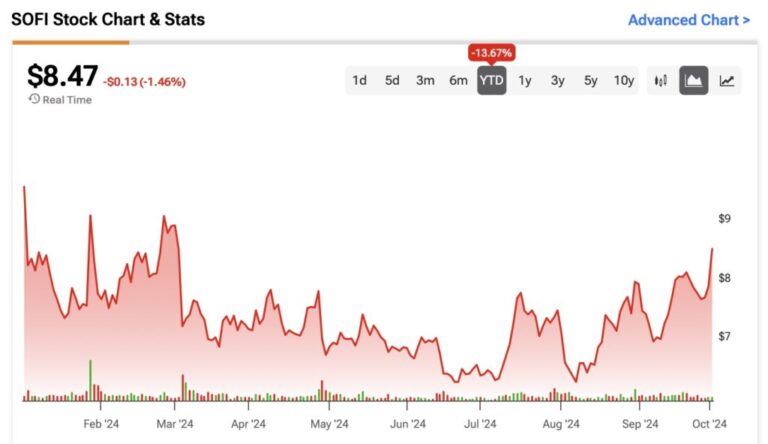SoFi Technologies (SOFI) has established itself as one of the most exciting fintech companies, offering a wide range of services and products that many traditional banks struggle to match. The stock has fallen about 10% this year, and we believe this decline is largely due to investors’ short-term focus on challenges, particularly the high interest rate environment that is now beginning to change. In this article, I outline five key reasons that support my bullish view on SOFI stock, especially at current levels.
Strong revenue growth and diversification
The first tenet of my SoFi investment theory is its impressive top-line growth. In its most recent second-quarter financial results, reported on July 30, SoFi posted a massive 22% year-over-year increase in adjusted net revenue to a record $597 million. Additionally, financial services and technology platform revenue increased 46% year-over-year and now accounts for 45% of total adjusted net revenue, up from just 38% in the year-ago period. This diversification from lending into financial services and technology platforms increases SoFi’s growth potential, reduces dependence on a single revenue stream, and increases the company’s resilience.
Additionally, SoFi has carved out a niche in financial services by targeting young, high-income consumers who are underserved by traditional banks. While most major banks offer limited specialized services, SoFi offers a comprehensive range of services, from student loans to estate planning, that allows us to meet the specific needs of this demographic.
Improving SoFi profitability
In addition to strong revenue growth, SoFi has also seen significant increases in profitability. The fintech has reported three consecutive quarters of profit, with GAAP net income of $17 million for the three months ending June 2024 (compared to a loss of $40 million in the year-ago period). This meaningful improvement increases investor confidence and shows that SoFi’s business model is sustainable and can grow profitably over time.
Additionally, SoFi’s focus on product development along with its commitment to operational efficiency positions it to drive long-term growth and profitability. Wall Street shares this optimism, predicting solid earnings growth over the next three years, from 2024 EPS of $0.11 to 2027 EPS of $0.64. This confirms the company’s strong future prospects.
Evaluation according to future growth prospects
The company’s current valuation is also attractive compared to its growth expectations. SoFi currently trades at a seemingly unreasonable forward P/E of 78x. However, if SoFi reaches $0.64 EPS by 2027, that multiple drops to 13.4x. This valuation is much closer to that of traditional banks, which typically trade at 11x to 13x earnings multiples.
That said, SoFi’s business is far from mature and earnings are still in its infancy, so the current P/E premium makes sense.
Membership growth and digital-first strategy
My fourth bullish point concerns the rapid growth of SoFi’s member base. In the second quarter of 2024, the company added 643,000 new members, an increase of 41% year over year, for a total of 8.77 million members. SoFi’s digital-first approach also eliminates the need for physical stores, lowering costs while meeting consumer demand for convenient, technology-driven financial services. This strategy positions SoFi to take advantage of the continued shift toward online banking and fintech innovation.
Robust loan business based on wise risk management
The fifth argument underlying my bullish view on SoFi is the potential macroeconomic relief. Management has been concerned for the past several quarters that rising interest rates could dampen economic activity, leading to job losses and delayed loan payments. As a result, management aimed to reduce lending and initially expected 2024 revenues to decline by at least 5%.
However, management’s outlook is likely to improve after the Fed cut interest rates by 0.5 percentage point a few weeks ago. SoFi may have survived the worst of the rising interest rate cycle. Lower interest rates typically improve economic activity and reduce the risk of loan losses.
Despite diversification efforts, SoFi’s balance sheet remains heavily concentrated in loans, with a loan-to-assets ratio of approximately 77.4%. Management’s vigilance was justified as an increase in defaults could seriously threaten performance. Notably, the 90-day personal loan delinquency rate fell from 72 basis points in the first quarter to 64 basis points in the most recent quarter, indicating that delinquencies may be peaking.
Is SOFI a buy, according to Wall Street analysts?
Despite the bullish argument presented in this article, Wall Street remains cautious about SOFI stock. Of the 14 analysts covering the stock, only 5 recommend it as a buy, 6 rate it as a hold and 3 recommend it as a sell. According to TipRanks, the overall consensus is a Hold. SOFI’s average price target is $8.27, nearly 5% below the recent market price.
conclusion
In summary, despite near-term challenges and cautious analyst sentiment, SoFi’s strong revenue growth, improving profitability, and strategic diversification make growth a compelling case for long-term investors at a reasonable valuation. There is some basis for this. With its rapidly expanding membership base and digital-first strategy, I believe the company is well-positioned to grow in the evolving fintech environment. This justifies bullish sentiment towards SOFI stock at its current price.
disclosure
Disclaimer


